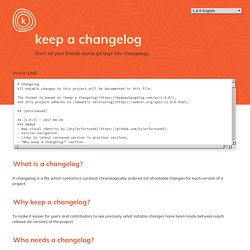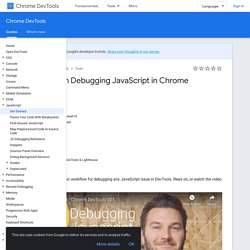

Keep a Changelog. What is a changelog?

A changelog is a file which contains a curated, chronologically ordered list of notable changes for each version of a project. Why keep a changelog? To make it easier for users and contributors to see precisely what notable changes have been made between each release (or version) of the project. Who needs a changelog? People do. How do I make a good changelog?
Guiding Principles Changelogs are for humans, not machines. Types of changes Added for new features. How can I reduce the effort required to maintain a changelog? Keep an Unreleased section at the top to track upcoming changes. This serves two purposes: People can see what changes they might expect in upcoming releases At release time, you can move the Unreleased section changes into a new release version section. Can changelogs be bad? Yes. Commit log diffs Using commit log diffs as changelogs is a bad idea: they're full of noise. The purpose of a commit is to document a step in the evolution of the source code. How to remember what you learn. “I don’t remember a damn thing.”

The book I held my hands was full of highlights. It seemed like I’ve got all colors of the rainbow on a page. Apparently, this didn’t help. When I tried recalling ideas from the book, I didn’t hear a thing. Just. Terrified, I started questioning how much I really know. I quickly did the math. In the past six months, I’ve devoured dozens of books, research papers, and studies on how people learn.
In this work, I outline my workflow so that you can try it out. Make it time-based, take regular breaks, and learn what you’re curious about. The most important thing is that my learning is time-based, not goal-based. It’s also important to not overload yourself and take breaks. As for material, I learn what I’m interested in. For example, if you’re learning JavaScript and you’re curious about it, you’ll go and figure out how JS runtime environment works in Chrome even though the tutorial doesn’t cover it.
Front-End Documentation, Style Guides and the Rise of MDX. Learn Development at Frontend Masters You can have the best open source project in the world but, if it doesn’t have good documentation, chances are it’ll never take off.

In the office, good documentation could save you having to repeatedly answer the same questions. Documentation ensures that people can figure out how things work if key employees decide to leave the company or change roles. Well documented coding guidelines help bring consistency to a codebase. If you’re writing long-form text, Markdown is clearly a great alternative to authoring HTML. This article is a broad overview of the tools available for writing documentation and for building style guides. #What is MDX? A .mdx file has exactly the same syntax as a regular Markdown file, but lets you import interactive JSX components and embed them within your content.
#Writing documentation with Docusaurus Docusaurus is made by Facebook and used by every Facebook open source project, apart from React. Docz Styleguidist Storybook. Get Started with Debugging JavaScript in Chrome DevTools This tutorial teaches you the basic workflow for debugging any JavaScript issue in DevTools.

Read on, or watch the video version of this tutorial, below. Step 1: Reproduce the bug Finding a series of actions that consistently reproduces a bug is always the first step to debugging. Click Open Demo. The demo opens in a new tab. Step 2: Get familiar with the Sources panel UI DevTools provides a lot of different tools for different tasks, such as changing CSS, profiling page load performance, and monitoring network requests. Open DevTools by pressing Command+Option+I (Mac) or Control+Shift+I (Windows, Linux). The Sources panel UI has 3 parts: The File Navigator pane. Step 3: Pause the code with a breakpoint A common method for debugging a problem like this is to insert a lot of console.log() statements into the code, in order to inspect values as the script executes. The console.log() method may get the job done, but breakpoints can get it done faster. Step 4: Step through the code Next steps.
Gestion sémantique de version 2.0.0. Semantic-release - Maintenance-releases.